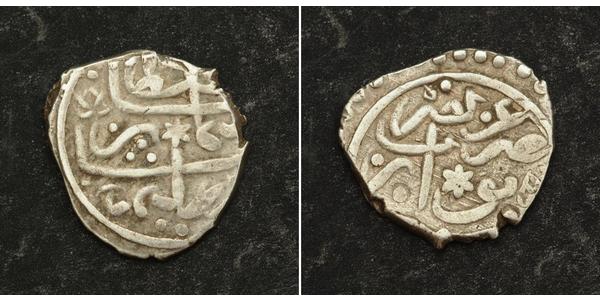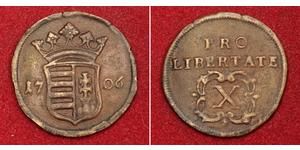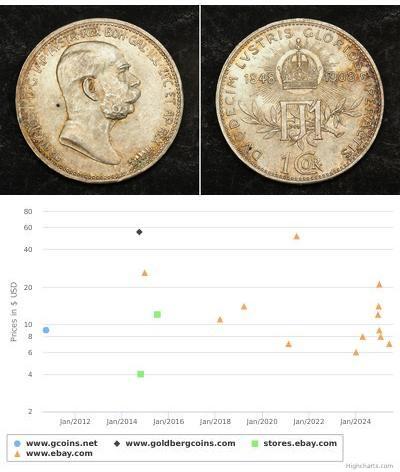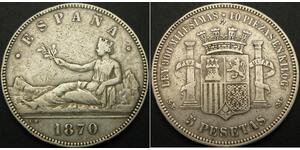(sold for $11.0)
1520, Ottoman Empire, Sulayman I. Silver Akce Coin. Novo Brdo (Novar) mint!
Reference: Pere 60. Denomination: Akce Mint Period: 1520-1566 Mint Place: Novar (Novo Brdo, Serbia) Ruler (Sultan): Sulayman I. "the Magnificent" Condition: Minor greenish deposits, struck lightly off-center, otherwise VF+ Diameter: 12mm Weight: 0.71gm Material: Silver
The akçe (Ottoman Turkish: آقچه) (Turkish pronunciation: [akʧe]) was the chief monetary unit of the Ottoman Empire, a silver coin. Three akçes were equal to one para. One-hundred and twenty akçes equalled one kuruş. Later after 1687 the kuruş became the main unit of account, replacing the akçe. In 1843, the silver kuruş was joined by the gold lira in a bimetallic system. Its weight fluctuated, one source estimates it between 1.15 and 1.18 grams. The name akçe originally referred to a silver coin but later the meaning changed and it became a synonym for money. The mint in Novo Brdo, a fortified mining town in the Serbian Despotate rich with gold and silver mines, began to strike akçe in 1441 when it was captured by the Ottoman forces for the first time.
Suleiman was infatuated with Hürrem Sultan, a harem girl of Ruthenian (Ukrainian) origin. In the West foreign diplomats, taking notice of the palace gossip about her, called her "Russelazie" or "Roxelana", referring to her Slavic origins. The daughter of an Orthodox Ukrainian priest, she was enslaved and rose through the ranks of the Harem to become Suleiman's favourite. Breaking with two centuries of Ottoman tradition, a former concubine had thus become the legal wife of the Sultan, much to the astonishment of observers in the palace and the city. He also allowed Hürrem Sultan to remain with him at court for the rest of her life, breaking another tradition—that when imperial heirs came of age, they would be sent along with the imperial concubine who bore them to govern remote provinces of the Empire, never to return unless their progeny succeeded to the throne.
Under his pen name, Muhibbi, Suleiman composed this poem for Roxelana:
"Throne of my lonely niche, my wealth, my love, my moonlight. My most sincere friend, my confidant, my very existence, my Sultan, my one and only love. The most beautiful among the beautiful… My springtime, my merry faced love, my daytime, my sweetheart, laughing leaf… My plants, my sweet, my rose, the one only who does not distress me in this world… My Istanbul, my Caraman, the earth of my Anatolia My Badakhshan, my Baghdad and Khorasan My woman of the beautiful hair, my love of the slanted brow, my love of eyes full of mischief… I'll sing your praises always I, lover of the tormented heart, Muhibbi of the eyes full of tears, I am happy.
Suleiman I (Sulayman, Turkish: Süleyman; almost always Kanuni Sultan Süleyman) (27 April 1494/1495/6 November 1494 – 5/6/7 September 1566), was the tenth and longest-reigning Sultan of the Ottoman Empire, from 1520 to his death in 1566. He is known in the West as Suleiman the Magnificent and in the East, as the Lawgiver (in Turkish Kanuni; al-Qanuni), for his complete reconstruction of the Ottoman legal system. Suleiman became a prominent monarch of 16th century Europe, presiding over the apex of the Ottoman Empire's military, political and economic power. Suleiman personally led Ottoman armies to conquer the Christian strongholds of Belgrade, Rhodes, and most of Hungary before his conquests were checked at the Siege of Vienna in 1529. He annexed most of the Middle East in his conflict with the Persians and large swathes of North Africa as far west as Algeria. Under his rule, the Ottoman fleet dominated the seas from the Mediterranean to the Red Sea and the Persian Gulf.
At the helm of an expanding empire, Suleiman personally instituted legislative changes relating to society, education, taxation, and criminal law. His canonical law (or the Kanuns) fixed the form of the empire for centuries after his death. Not only was Suleiman a distinguished poet and goldsmith in his own right; he also became a great patron of culture, overseeing the golden age of the Ottoman Empire's artistic, literary and architectural development.
In a break with Ottoman tradition, Suleiman married (as his fourth wife) a harem girl, Roxelana, who became Hürrem Sultan; her intrigues as queen in the court and power over the Sultan have become as famous as Suleiman himself. Their son, Selim II, succeeded Suleiman following his death in 1566 after 46 years of rule.

|
Posted by:
anonymous 2018-08-02 |
5 Peseta First Spanish Republic (1873 - 1874) Silver
group has 38 coins / 33 prices
⇑
















-300-150-DTwKX9ISLbYAAAFanYlMgKms.jpg)






